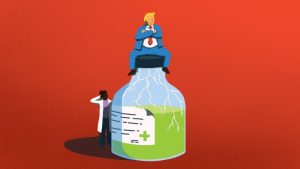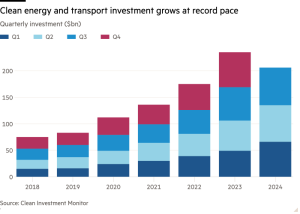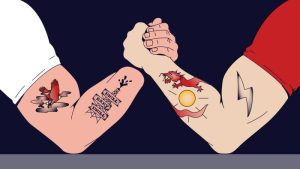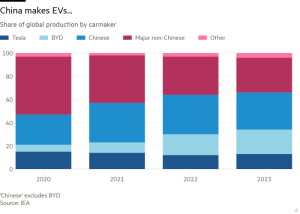Weaponised autism and the extremist threat facing children
It is high summer in the English suburbs, and the hedges around Josh’s house are cut sharp as a Lego brick. He has mown the grass to an exacting stripe and is clipping the ragged bay tree. Josh, who is 13, has few friends and spends his school holidays gardening. From inside the house, his parents watch him work, stranded between pride and despair.
For the past two years, Josh’s teachers have complained of “persistent poor behaviour”, ranging from making inappropriate comments to hitting a fellow pupil who had been taunting him. An educational psychologist concluded that Josh had autism spectrum disorder (ASD) but recommended his parents, Mike and Sarah, seek a formal NHS diagnosis. In the meantime, the school continued to sanction Josh for small infractions — forgetting his pencil or kicking a chair. His parents pointed out repeatedly that his suspected autism led him to be forgetful, lose focus and lash out when confronted. Teachers countered that his condition did not excuse his conduct.
The situation escalated during a PE lesson in June, when a teaching assistant reported that Josh had shouted, “Get them out! Reform UK” at a non-white pupil, apparently referencing the populist political party, which takes a hard line on immigration. Josh disputed having mentioned “Reform UK” and said that “get them out” was a cricketing reference, as he was bowling at the time. He was given detention, during which he wrote a story about three Asian men embarking on an ill-fated adventure to join Isis-K, the Afghan-based Islamist terror group. Their hopes of glory collapse when they are caught by counter-terror police, convicted and sent to prison. The final line reads, “Moral of the story: don’t try and join Isis-K”.
A few days later, Josh was given another detention for playing with a water pistol at break time. His parents were called in for a meeting to discuss it. As they got up to leave, the assistant headteacher said in passing that, as a result of Josh’s Isis-K story, the school had referred him to Prevent, the UK’s deradicalisation programme. “Oh, we don’t think he’s a terrorist or anything,” the deputy head joked, before leaving the room to let his junior colleague answer questions. Stunned, Josh’s parents stumbled through the rest of the meeting. In the car on the way home, Sarah googled “what is Prevent?” on her phone.
Created in the wake of 9/11, Prevent is unique among counter-terror initiatives in the west. It aims to identify people at risk of radicalisation before they have committed any crime. The programme relies on information from teachers, clinicians and local government officials, who are under a legal duty to report anyone, of any age, suspected of harbouring extremist views. Counter-terrorism police then sift out those deemed to be a genuine threat. The most high-risk individuals are offered support known as “Channel intervention”, which can take the form of housing or employment assistance, religious mentoring or mental health treatment. Participation is voluntary.
Over the past two decades, the programme has been accused of targeting Muslims, of turning public servants into informants and being a dragnet that ensnares innocent people. Following a tide of negative stories in the British media, the Home Office instigated an independent review in 2019. Published last year, it concluded that Prevent was “broadly right in its objectives, admirable in its intentions” and fulfilled many of its functions “to good effect”.
But as ministers sought to stem public criticism, a new problem was evolving behind the scenes, a Financial Times investigation has found. Increasingly, Britons being referred to Prevent are not only children, but also people like Josh who are autistic. The FT has obtained estimates from psychiatrists working with counter-terrorism police suggesting that people with autism account for about 13 per cent of their casework, against a population base-rate of 1 per cent. A separate Home Office analysis on autism and Prevent — commissioned under the last government and seen by the FT — indicates that one-quarter of those receiving a Channel intervention have ASD, if those with suspected diagnoses are included. It seems that a high number of minors with neurodiversity are being swept up in a programme designed to reduce the threat of violent extremism.
There is some consensus among forensic psychiatrists and criminal psychologists that, while people with autism and related conditions are less likely to break the law than their neurotypical peers, they may be more vulnerable to grooming and radicalisation. This apparent trend has spread far beyond the UK, with recent cases in the US, Canada and Australia. So has the conundrum for police and intelligence professionals more used to tracking groups of adult terrorists meeting in person than responding to what some call “weaponised autism”, among teenagers recruited online.
13%Estimated casework of psychiatrists working with counter-terrorism police assessing people with autism, against a population base rate of 1%
This month, Ken McCallum, the director-general of MI5, warned in his annual threat assessment of a growing danger of children being drawn into “poisonous online extremism”, driven by propaganda which he said showed a “canny understanding of online culture”. “Being able to access inspirational and instructional material from your bedroom is a lower bar than . . . accessing a particular room in a particular setting with a particular preacher”, McCallum added, suggesting that rightwing extremists were especially adept at drawing in young people.
Given the relative infancy of research into autism and extremism, and the vulnerability of those involved, this issue is sensitive and data is scarce. The FT interviewed more than 40 people, including parents of autistic children, people with knowledge of Prevent interventions, current and former police officers and intelligence officials, lawyers, psychiatrists and psychologists in the UK and allied counties. The vast majority of people with autism pose no terrorist risk or danger to society. No one with this condition deserves to be stigmatised. But the trends exposed by Prevent indicate that past counter-terrorism doctrines may not accurately reflect a new reality. And that our understanding of what represents a national security threat is increasingly out of date.
The phrase “weaponised autism” originated as a meme in the autism community online, in the early 2010s. At first, it was used to extol the abilities some autistic people display in conducting research. One digital sticker posted on the anonymous bulletin board 4chan defines the term as “impressive capabilities of socially awkward, tech-savvy internet users”. But over time, extremists have corrupted it as a shorthand for exploiting the vulnerable and recruiting them to malign causes.
Alistair Barfield experienced this first hand. Growing up in Grimsby, a former fishing port on the east coast of England, he was diagnosed with autism at the age of seven, expelled from primary school, sent to a boarding school for gifted pupils, and went on to study teaching at university. It was there that his interest in the tabletop game Warhammer led him to 4chan and gaming sites, where he found himself in unfamiliar ideological territory.
Before long, he was wearing a Maga cap and had become a disciple of the American far-right conspiracist Alex Jones. Barfield wore a T-shirt that read “facts don’t care about your feelings” to lectures and sought out arguments with “the Libs”. He’d started down the path to extremism but, at the last moment, pulled back. Meeting a trans person one day and realising they were not, as he had been led to believe, “the enemy”, was a turning point. “As an autistic person, I didn’t understand dog whistles,” he tells me. “I didn’t understand the subtext. I took everything at face value, and one day I was like, ‘oh, a lot of this is antisemitic rhetoric. A lot of this is Islamophobia’.”
After graduating, Barfield began working with autistic children in schools, but grew concerned about how susceptible his pupils were to extremist beliefs. He became involved with Prevent, helping deradicalisation counsellors and Home Office officials understand online dangers from the perspective of someone with neurodiversity. He’s now a consultant, providing training to schools, colleges and community groups about combating extremism. “It’s clear that every single organisation that works with young autistic people is saying, ‘something’s going on here’,” he says. “Something we don’t understand and that we’re not equipped to talk about.”
In Barfield’s experience, there are numerous factors that make autistic people vulnerable to radicalisation. “We have something that I call an inability to discern nefarious intent . . . an assumption that the person we are engaging with has our best interests at heart.” He says people who are neurodiverse often have “incredibly negative experiences” with figures of authority. “When you live in a world that is fundamentally not made for you, that can be an inherently traumatic experience. And then if you have negative experiences with social workers, teachers, the police, this makes you reluctant to engage with services that try to assist you.”
FT Edit
This article was featured in FT Edit, a daily selection of eight stories, handpicked by editors to inform, inspire and delight. Explore FT Edit here ➼
As people with autism grow older, many excel in the workplace. But globally, adults with ASD experience high levels of unemployment. Only three in 10 UK adults with autism are in work, according to a government-commissioned report published this year. “We are disenfranchised. We don’t engage with the world,” Barfield explains. “So when somebody hands us an active community that we can feel a part of, where we can regurgitate the same things, talk to people who have shared special interests, we are prime candidates for radicalisation.” He adds that for some autistic people, the tendency towards a binary understanding of injustice can foster an eagerness to accept plausible scapegoats — women, immigrants — for their problems.
Myrieme Nadri-Churchill, a psychotherapist who runs Parents4Peace, a non-profit deradicalisation group based in the US, concurs. She says working with teenagers with autism who were radicalised online, many during the Covid-19 lockdown, led her to understand more about the lure of extremist beliefs. “Being radicalised is not a negative experience for those kids that are being recruited,” Nadri-Churchill says. “Kids on the spectrum often lack control over what’s happening to them. And when they’re being radicalised, it’s almost like moving from powerlessness to power. You suddenly feel stronger. You don’t feel hopeless.”
One of her theories is that violent extremists become attractive as figureheads because they can help vulnerable children visualise defeating playground bullies or critical teachers. Some extremist groups, apparently attuned to this dynamic, pose as forums in which people with neurodiversity are rising up against the establishment.
Barfield is frustrated that schools merely “manage” children, rather than truly understanding what they are experiencing, and blames the disconnect between his generation of digital natives and their analogue elders. He is wry and self-deprecating about his lifestyle and how it differs from mine. (“I grew up online. I can’t imagine meeting friends in a park; that’s weird. Why, when we could go on World of Warcraft?”) But he also feels real irritation about the failure of teachers, police and other professionals to understand the world as it is, rather than how it used to be. “We are so late to recognise trends. We are so late to the game, the internet changes every single day,” Barfield says. “Police are still hyper-focused on . . . visible forms of radicalism. They’re not focused on Discord groups. They’re not focused on Roblox servers.”
If UK police have struggled to patrol the internet, the overlap between autism and extremism is becoming impossible to ignore. Maria Lovegrove, the Metropolitan Police officer who oversees interventions by UK counter-terrorism police, has noticed the risks changing over her 20 years in the field. “We still see absolutely the threat emanating from overseas and from organised terrorist networks and groups,” she says. “But more and more, we’re wrestling with increasing numbers of people in our casework, both in Prevent and investigations, where their primary vulnerability . . . is mental health or neurodiversity.”
There has also been a sharp rise in the number of children becoming terrorist offenders. Last year, nearly one-fifth of all terrorism arrests in the UK were individuals 17 years old or under, the highest rate ever. “It’s a real shift to the fact that people can present as being vulnerable and dangerous simultaneously,” Lovegrove says, when I meet her on the eighth floor of New Scotland Yard.
Lovegrove interviewed for her first counter-terrorism job in 2005, the day before the attacks on London’s transport network during which 52 people were killed. This period, so soon after 9/11, marked the height of the threat from Islamist groups such as al-Qaeda in the UK. These days there are fewer human networks for police to surveil on foot and more children operating alone in their bedrooms. The high prevalence of minors in counter-terrorism work “takes a toll” on the officers involved in managing them, according to Lovegrove. Neither she nor her colleagues got into this job to arrest and send young people to prison, she says.
Alarmed by these trends, Lovegrove’s teams have begun collaborating with the NHS to better understand how neurodiversity or conditions such as schizophrenia or psychosis might affect a person’s risk of offending. The Clinical Consultancy Service (CCS) opened without fanfare this spring. Its combined staff of 29 clinicians — psychiatric nurses, consultant forensic psychiatrists, forensic psychologists and a forensic social worker with training in autism — work in counter-terrorism policing offices across the country. This means they are on site to advise how to handle a case as soon as a relevant Prevent referral comes in. But they also work on the full spectrum of counter-terrorism activities, spanning ongoing investigations and post-release offenders. CCS will manage a caseload of about 1,600 individuals each year.
Most of the high-risk cases involve complex mental health conditions, but staff are increasingly encountering neurodiversity as well. In a typical Prevent case, clinicians will form a view about what that person needs, such as an assessment by the UK’s Child and Adolescent Mental Health Service (CAMHS). Then, they may contact the individual’s GP or mental health clinicians direct, suggesting that the person may be at risk and explaining why. In some cases, they request access to an individual’s health records. Often, but not always, the staff at CAMHS or the NHS will escalate the case as a result of what CCS has told them. This can mean a patient is seen sooner than they might otherwise have been, given long waiting lists such as the one Josh is still on. At no point do CCS staff play a direct role in their healthcare.
Richard Taylor, the forensic psychiatrist who heads the clinical side of CCS, has spent his career assessing criminals including the radical Islamist cleric Abu Hamza al-Masri, now serving a life sentence in the US for terrorism offences. Taylor says working with police is a “sensitive” process but that his clinicians are always clear about what their purpose is. “We’re NHS staff, working with the [counter-terrorism] police . . . We’re concerned that this individual may be posing a risk to the public, because it looks to us . . . that they may be suffering a relapse,” Taylor might say to an individual’s doctor. “What we’d like to know, if you’re willing . . . is, are they in treatment?”
Taylor, who is aware of potential controversy, insists there are multiple safeguards for how medical data is used. The records that come back are not shared widely with counter-terrorism police. He says patient details would never be given to assist a police investigation. Still, some clinicians, uncomfortable with the approach, have refused to hand over patient records.
Charlotte Heath-Kelly, a politics professor at the University of Warwick who spent several months researching CCS, concluded that it creates a “surveillance relationship” between NHS workers and patients. She argues the very existence of a mental health function within counter-terrorism policing shows the deficit in services. “This is how twisted the world has become,” Heath-Kelly says. “That we’re thinking, well, the NHS and schools have failed . . . isn’t it good that counter-terrorism policing is picking up on these kids?”
Ever since David Cameron’s Conservative-led government introduced austerity in 2010, police chiefs have warned of their officers becoming the backstop for failures elsewhere in the public sector. New data from the Children’s Commissioner shows that under-18s wait an average of two years and two months for an autism diagnosis through community healthcare. Some 400,000 children in England are seeking support for a suspected neurodevelopmental condition, the Commissioner found. The National Autistic Society, a UK charity for autistic people and their families, describes the system for autistic children as “broken”. It told the FT of cases in which young people only received support after being referred to Prevent, and says that some children are being referred inappropriately in the hope of fast-tracking access to healthcare.
But Prevent, Heath-Kelly says, “is not the answer”. Neither is counter-terrorism policing. “These kids need services . . . We can’t view a national security programme as a way to get people mental healthcare.”
To help understand the impact of the new programme, CCS has begun to collect data about the prevalence of certain conditions in its work. The FT has obtained estimates from clinicians indicating that 13 per cent of CCS cases, not limited to Prevent, involve people with autism. However, the true figure is likely to be higher given that many individuals do not have an official diagnosis. Taylor says that sitting in his case meetings each week, he is struck by “a large number of under-18s with autism spectrum disorder”. A Home Office report seen by the FT suggested that autism or suspected autism was present in just over one-quarter of Channel cases in 2019 and 2020. (The Home Office declined to comment on this report.)
Lovegrove is sensitive to the idea that CCS or her team are making explicit connections between neurodiversity and radicalisation. “I’m very aware that some people think that there’s a stigma being attached to this, that if you’re neurodivergent, maybe you’re more likely to become a terrorist,” she says. “That’s not what we’re saying. And it’s certainly not the narrative that’s coming from any of this work. What we must do is . . . drive better outcomes for those individuals and divert them away from the risks that perhaps they’re close to.”
In Room One at Chesterfield Coroner’s Court, the blinds have been drawn against the slanting September sunlight. The room is airless and unusually full. There are so many organisations represented at this pre-inquest hearing — the Home Office, counter-terrorism police, MI5, the Crown Prosecution Service, three separate NHS trusts and a residential children’s home — that the proceedings risk becoming a surrogate public inquiry. Everyone here is gathered to understand why, on May 19 2022, 16-year-old Rhianan Rudd took her own life.
Rudd’s case is an example of what can happen when children are not, in Lovegrove’s words, successfully “diverted away”. Rudd, who was autistic, was 14 when she was radicalised online by an American neo-fascist terrorist. Rudd’s mother described her as a girl who fixated on things, absorbing extremist views “like a sponge”. Eventually, her mother became so concerned about her racist and antisemitic beliefs that she referred her to Prevent.
Within a month, Rudd was arrested by counter-terrorism police and later charged with six terrorism offences, including possessing instructions for making weapons and explosives. At the same time, allegations were made that Rudd had been groomed and sexually exploited by her recruiter. The Home Office eventually concluded that she had been trafficked and exploited and, seven months later, the charges were dropped. But by then, Rudd’s mental health had significantly deteriorated. Five months later, she died by suicide in a children’s home.
Rudd should have been seen “as a victim rather than a terrorist”, her mother told the BBC last year. “She’s a child, an autistic child. She should have been treated as a child . . . ” At last month’s hearing, lawyers confirmed that MI5 had been monitoring Rudd and had handed intelligence to police, raising questions about what the state had known before she was charged. Jesse Nicholls, representing her family, argued that there was a strong public interest in examining the state’s role in her death. Lawyers for the Home Office have explained that MI5 considers matters such as mental health issues in the course of its work, but that providing care and support “is not part of its . . . role”.
Cases like Rudd’s raise questions about how to manage children who are victims as well as potential perpetrators. In 2021, a British 17-year-old called Daniel Harris posted a series of violent far-right videos calling for armed insurrection from his bedroom in the north of England. His posts inspired two terrorists in the US, including one who went on to kill 10 people in Buffalo, New York. Harris, who has suspected autism but had refused assessment before his arrest, is now serving an 11-year sentence in a young offender’s institution. James Walker, the barrister who represented Harris, used a modern slavery defence to argue that the teenager had been groomed and told me Harris’s neurodiversity made him vulnerable. “His autism . . . made him easier to groom,” Walker says. “You’re not born wanting to commit genocide against different races. This stuff is taught.”
As many researchers have argued, it is not autism alone but often a combination of factors that make some children and young people susceptible to radicalisation. These can include mental health issues, previous trauma and, sometimes, family influences.
Gina Vale, a lecturer in criminology at the University of Southampton, has coined the phrase “digital human trafficking” to describe the phenomenon by which some children are effectively forced into relationships with terrorist recruiters and other criminals. Having studied a number of cases over the past decade, Vale tells me she does not believe the UK government has a “concrete strategy” to respond in a sufficiently nuanced way.
Vale and fellow academic Hannah Rose have compiled a catalogue of children convicted of terrorism offences in England and Wales since 2016, known as the Childhood Innocence Project. Research based on these publicly available cases, due to be published later this year, found that 31 per cent of minors had a formal diagnosis of neurodiversity or mental health conditions. Among extreme right-wing offenders, the percentage is even higher, at 45 per cent.
Vale and Rose have observed that teenagers are engaging in “peer-to-peer recruitment”, setting up their own violent extremist groups or networks online and designing content specifically for young consumers. This breeds networks which are connecting minors across borders.
1,600Current annual caseload of the counter-terrorism Clinical Consultancy Service, which has a combined staff of 29 clinicians
The international nature of these developments has persuaded the UK’s Five Eyes intelligence partners — the US, Canada, Australia and New Zealand — that action must be taken, even if they are not yet sure what. Chris O’Leary, who left the FBI last year after two decades overseeing counter-terrorism operations, says that towards the end of his career he started to notice people with neurodiversity “being present in theatre, in conflict zones and outside them to carry out attacks, because they’re more susceptible, they’re more exploitable than neurotypical people might be”. Working with social media companies to police online content has only a limited effect because most nefarious actors have already moved to alternative platforms, O’Leary says.
The FT learnt that the FBI and the Department of Justice looked into creating a nationwide deradicalisation programme, similar to Prevent. However, it proved impossible to connect security infrastructure and medical infrastructure at a federal level in the US. “The challenge with terrorism investigations is the sensitivity of FBI investigations and our inability to share that information with the counsellors and the healthcare professionals,” O’Leary says. “And then the other challenge is from their side. So if we did introduce [clinicians] into our cases, if they do an assessment of somebody and say, ‘This person has this diagnosis,’ they cannot share that with us because of privacy laws.”
Sitting at the nexus of so many public services gives Prevent an advantage. Its much-criticised pervasiveness makes it is a tripwire for new trends. As such, it may be more attuned to the changing nature of terrorism. The weakness of Prevent is that it necessarily views all individuals as a security threat, rather than as victims of grooming, or as patients.
One warning in the independent Home Office-commissioned review of the programme was that more and more referrals are for people who are “of doubtful relevance” to counter-terrorism. The number of individuals referred to Prevent and categorised as vulnerable but presenting no clear ideology or counter-terrorism risk has increased every year since 2019/20, rising from one-quarter of all referrals initially to 37 per cent in 2022/23, according to the latest data. The review suggested that one explanation for the growth in lower-risk cases was that public agencies were unsure of how else to provide support for vulnerable individuals who have been flagged to the system.
The problem with referring children with ASD to Prevent, says Layla Aitlhadj, director of Prevent Watch — an NGO which is critical of the programme and supports families affected by it — is that it risks “criminalising their vulnerability” instead of providing them with support.
The names of all individuals flagged to Prevent, including those not considered serious enough for a Channel intervention, remain on file for six years, so a referral has a lasting impact. One of the review’s strongest criticisms was that there was “understandable unease” about children’s data remaining on a police database for so long when no crime had been committed. It recommended the data retention period for cases requiring no further action be halved to three years, but counter-terrorism police rejected the idea. (Parents can request that police remove their child’s name; if denied, some have progressed to a judicial review.) The police and Home Office still consider that it is better to receive referrals which turn out to be unnecessary than for someone who needs support to be missed.
Even in cases that present a clear terrorism risk, police may need to reconsider what exactly that risk is and how to manage it. One idea put forward by Jonathan Hall, the UK’s independent reviewer of terrorism legislation, is that instead of arresting minors and subjecting them to the stress and delay of a criminal justice process, they could be more quickly dealt with under a new system of “child diversion orders”. These would immediately restrict internet use and impose stringent conditions on children who appear to present a threat, to stop them committing offences and later facing charges.
Hall has also begun to ask a more fundamental question about the state’s approach to these individuals. “Many of these people, these children and people with autism, qualify as terrorists,” he says. “But I’ve often had some doubt in my mind, to what extent do they hit the national security threshold?”
The first few weeks after Josh’s referral to Prevent were like bereavement. Sarah woke up feeling her old self but, when she remembered what had happened, sadness consumed her. She felt like the school had launched a missile into her family’s lives with no thought for its impact. The referral document, which listed a number of incidents leading up to the Isis-K story, read to her as if teachers had been building a case against Josh over the course of many months. “I was worried that they’d take him away from us,” Sarah says.
400,000Children in England are currently seeking support for a suspected neurodevelopmental condition
Having asked Josh about his story, his parents now know that the detail which disturbed the school had been gleaned from an ITV documentary in which the actor Ross Kemp is embedded with counter-terrorism police. “The thing that annoyed me the most was that the teachers kept saying it was the detail [in the story] that was worrying,” says Josh’s dad, Mike. “But detail is what Josh does, because of his neurodiversity. To me that’s discriminating because of what he is. That’s him. He’s into detail. His condition makes him obsessed with detail. You ask him about a lawnmower, and he’ll tell you what the grassbox size is, what the engine size is.”
By late summer, Josh’s parents had been told that Prevent was not taking up the case, but they were worried about Josh’s name being logged in the police’s files. “You don’t know when this thing is going to flag up in the future,” Mike says. “When they’re going to tap his name into a system and someone sees, oh, there was a question mark about him. The record — I just want there to be no trace of it at all.”
The referral shook the family’s trust in the school so badly that Mike and Sarah did not send Josh back at the start of term. A nearby school, which had an opening, retracted its offer after receiving a behavioural report from his previous teachers. Sarah calls the council every week to inquire about progress in finding a place and has been warned there is little prospect of any spaces before late autumn. Josh, having done all he can in his own garden, has moved on to tending others in the neighbourhood.
In this limbo, Sarah has had time to reflect. She now believes the school used Prevent to force out a pupil they could not manage. “I think they’ve sort of abused their position,” she tells me in our final conversation. She acknowledges that her son can be unpredictable, that she sometimes struggles to get through to him. But she still cannot believe that they have landed here. “We have needed support for Josh for a long time with his autism, and we got a Prevent referral.” She pauses, bewildered. “Is that really the best anybody could do?”
Helen Warrell is an investigative reporter at the Financial Times.
The names Josh, Mike and Sarah are pseudonyms used at the family’s request to protect their identities
Follow @FTMag to find out about our latest stories first and subscribe to our podcast Life and Art wherever you listen
#Weaponised #autism #extremist #threat #facing #children







